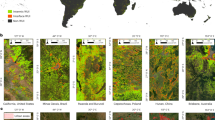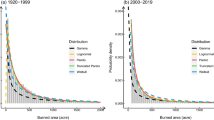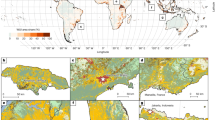Abstract
An increasing number of wildfire disasters have occurred in recent years in the United States. Here we demonstrate that cumulative primary human exposure—the population residing within the perimeters of large wildfires—was 594,850 people from 2000 to 2019 across the contiguous United States (CONUS), 82% of which occurred in the western United States. Primary population exposure increased by 125% in the CONUS in the past two decades; it was noted that there were large statistical uncertainties in the trend analysis due to the short study timeline. Population dynamics from 2000 to 2019 alone accounted for 24% of the observed increase rate in human exposure, and an increased wildfire extent drove the majority of the observed trends. In addition, we document the widespread exposure of roads (412,155 km) and transmission powerlines (14,835 km) to large wildfires in the CONUS, with a relative increase of 58% and 70% in the past two decades, respectively. Our results highlight that deliberate mitigation and adaptation efforts to help societies cope with wildfires are ever more needed.
This is a preview of subscription content, access via your institution
Access options
Access Nature and 54 other Nature Portfolio journals
Get Nature+, our best-value online-access subscription
$29.99 / 30 days
cancel any time
Subscribe to this journal
Receive 12 digital issues and online access to articles
$119.00 per year
only $9.92 per issue
Buy this article
- Purchase on Springer Link
- Instant access to full article PDF
Prices may be subject to local taxes which are calculated during checkout



Similar content being viewed by others
Data availability
The fire-burned-area data are available through the Monitoring Trends in Burn Severity programme at https://www.mtbs.gov/index.php/direct-download. The gridded population dataset (WorldPop) is available at https://developers.google.com/earth-engine/datasets/catalog/WorldPop_GP_100m_pop#description. The road shapefiles are available through TIGER: US Census Roads at https://developers.google.com/earth-engine/datasets/catalog/TIGER_2016_Roads#description. Finally, the electricity power grid data are available at https://zenodo.org/record/3538890#.Yg6cFN_MKHs.
References
Abatzoglou, J. T. et al. Projected increases in western US forest fire despite growing fuel constraints. Commun. Earth Environ. https://doi.org/10.1038/s43247-021-00299-0 (2021).
Dennison, P. E., Brewer, S. C., Arnold, J. D. & Moritz, M. A. Large wildfire trends in the western United States, 1984–2011. Geophys. Res. Lett. 41, 2928–2933 (2014).
Iglesias, V., Balch, J. K. & Travis, W. R. US fires became larger, more frequent, and more widespread in the 2000s. Sci. Adv. 8, eabc0020 (2022).
Marlon, J. R. et al. Long-term perspective on wildfires in the western USA. Proc. Natl Acad. Sci. USA 109, E535–E543 (2012).
Alizadeh, M. R. et al. Warming enabled upslope advance in western US forest fires. Proc. Natl Acad. Sci. USA 118, e2009717118 (2021).
Pechony, O. & Shindell, D. T. Driving forces of global wildfires over the past millennium and the forthcoming century. Proc. Natl Acad. Sci. USA 107, 19167–19170 (2010).
Khorshidi, M. S. et al. Increasing concurrence of wildfire drivers tripled megafire critical danger days in southern California between 1982 and 2018. Environ. Res. Lett. 15, 104002 (2020).
Radeloff, V. C. et al. Rapid growth of the US wildland-urban interface raises wildfire risk. Proc. Natl Acad. Sci. USA 115, 3314–3319 (2018).
Bowman, D. M. et al. Human exposure and sensitivity to globally extreme wildfire events. Nat. Ecol. Evol. 1, 58 (2017).
Manzello, S. L. et al. FORUM position paper the growing global wildland urban interface (WUI) fire dilemma: priority needs for research. Fire Saf. J. https://doi.org/10.1016/j.firesaf.2018.07.003 (2018).
Ager, A. A. et al. Wildfire exposure to the wildland urban interface in the western US. Appl. Geogr. 111, 102059 (2019).
Andela, N. et al. The Global Fire Atlas of individual fire size, duration, speed and direction. Earth Syst. Sci. Data 11, 529–552 (2019).
Balch, J. K. et al. Human-started wildfires expand the fire niche across the United States. Proc. Natl Acad. Sci. USA 114, 2946–2951 (2017).
Ager, A. A. et al. Wildfire exposure and fuel management on western US national forests. J. Environ. Manag. 145, 54–70 (2014).
Bowman, D. M. et al. The human dimension of fire regimes on Earth. J. Biogeogr. 38, 2223–2236 (2011).
Kramer, H. A., Mockrin, M. H., Alexandre, P. M., Stewart, S. I. & Radeloff, V. C. Where wildfires destroy buildings in the US relative to the wildland–urban interface and national fire outreach programs. Int. J. Wildland Fire 27, 329–341 (2018).
Higuera, P. E. et al. Shifting social-ecological fire regimes explain increasing structure loss from Western wildfires. PNAS Nexus 2, pgad005 (2023).
Bowman, D. M. et al. Vegetation fires in the Anthropocene. Nat. Rev. Earth Environ. 1, 500–515 (2020).
Peterson, G. C. L., Prince, S. E. & Rappold, A. G. Trends in fire danger and population exposure along the wildland–urban interface. Environ. Sci. Technol. 55, 16257–16265 (2021).
Zhao, X., Lovreglio, R., Kuligowski, E. & Nilsson, D. Using artificial intelligence for safe and effective wildfire evacuations. Fire Technol. 57, 483–485 (2021).
Masri, S., Scaduto, E., Jin, Y. & Wu, J. Disproportionate impacts of wildfires among elderly and low-income communities in California from 2000–2020. Int. J. Environ. Res. Public Health 18, 3921 (2021).
Andersen, L. M. & Sugg, M. M. Geographic multi-criteria evaluation and validation: a case study of wildfire vulnerability in Western North Carolina, USA following the 2016 wildfires. Int. J. Disaster Risk Reduct. 39, 101123 (2019).
Eidenshink, J. et al. A project for monitoring trends in burn severity. Fire Ecol. 3, 3–21 (2007).
Sorichetta, A. et al. High-resolution gridded population datasets for Latin America and the Caribbean in 2010, 2015, and 2020. Sci. Data 2, 150045 (2015).
US Census Bureau TIGER/Line Shapefiles Technical Documentation (US Department of Commerce, 2017); https://www.census.gov/programs-surveys/geography/technical-documentation/complete-technical-documentation/tiger-geo-line.html
Arderne, C., Zorn, C., Nicolas, C. & Koks, E. E. Predictive mapping of the global power system using open data. Sci. Data 7, 19 (2020).
Kolden, C. A., Lutz, J. A., Key, C. H., Kane, J. T. & van Wagtendonk, J. W. Mapped versus actual burned area within wildfire perimeters: characterizing the unburned. For. Ecol. Manag. 286, 38–47 (2012).
Li, S. & Banerjee, T. Spatial and temporal pattern of wildfires in California from 2000 to 2019. Sci. Rep. 11, 8779 (2021).
Jin, Y. et al. Identification of two distinct fire regimes in Southern California: implications for economic impact and future change. Environ. Res. Lett. 10, 094005 (2015).
Mietkiewicz, N. et al. In the line of fire: consequences of human-ignited wildfires to homes in the US (1992–2015). Fire 3, 50 (2020).
Modugno, S., Balzter, H., Cole, B. & Borrelli, P. Mapping regional patterns of large forest fires in wildland–urban interface areas in Europe. J. Environ. Manag. 172, 112–126 (2016).
Hawbaker, T. J. et al. Human and biophysical influences on fire occurrence in the United States. Ecol. Appl. 23, 565–582 (2013).
Andela, N. et al. A human-driven decline in global burned area. Science 356, 1356–1362 (2017).
Blanchi, R., Lucas, C., Leonard, J. & Finkele, K. Meteorological conditions and wildfire-related houseloss in Australia. Int. J. Wildland Fire 19, 914–926 (2010).
Abatzoglou, J. T., Rupp, D. E., O’Neill, L. W. & Sadegh, M. Compound extremes drive the western Oregon wildfires of September 2020. Geophys. Res. Lett. 48, e2021GL092520 (2021).
Abatzoglou, J. T., Juang, C. S., Williams, A. P., Kolden, C. A. & Westerling, A. L. Increasing synchronous fire danger in forests of the western United States. Geophys. Res. Lett. 48, e2020GL091377 (2021).
Liu, Z., Wimberly, M. C., Lamsal, A., Sohl, T. L. & Hawbaker, T. J. Climate change and wildfire risk in an expanding wildland–urban interface: a case study from the Colorado Front Range Corridor. Landsc. Ecol. 30, 1943–1957 (2015).
Alizadeh, M. R. et al. Increasing heat‐stress inequality in a warming climate. Earth Future 10, e2021EF002488 (2022).
Swain, D. L. et al. Increased flood exposure due to climate change and population growth in the United States. Earths Future 8, e2020EF001778 (2020).
Miller, H. These are the victims of the Camp Fire. KCRA https://www.kcra.com/article/these-are-the-victims-of-camp-fire/32885128# (2020).
Burke, M. et al. The changing risk and burden of wildfire in the United States. Proc. Natl Acad. Sci. USA 118, e2011048118 (2021).
Fann, N. et al. The health impacts and economic value of wildland fire episodes in the US: 2008–2012. Sci. Total Environ. 610, 802–809 (2018).
Williams, A. P. et al. Growing impact of wildfire on western US water supply. Proc. Natl Acad. Sci. USA 119, e2114069119 (2022).
Fraser, A. M., Chester, M. V. & Underwood, B. S. Wildfire risk, post-fire debris flows, and transportation infrastructure vulnerability. Sustain. Resilient Infrastruct. 7, 188–200 (2020).
Fowler, M. et al. A dataset on human perception of and response to wildfire smoke. Sci. Data 6, 229 (2019).
Rappold, A. G., Reyes, J., Pouliot, G., Cascio, W. E. & Diaz-Sanchez, D. Community vulnerability to health impacts of wildland fire smoke exposure. Environ. Sci. Technol. 51, 6674–6682 (2017).
Wang, D. et al. Economic footprint of California wildfires in 2018. Nat. Sustain. 4, 252–260 (2021).
Koks, E. E. et al. A global multi-hazard risk analysis of road and railway infrastructure assets. Nat. Commun. 10, 2677 (2019).
Cova, T. J., Dennison, P. E. & Drews, F. A. Modeling evacuate versus shelter-in-place decisions in wildfires. Sustainability 3, 1662–1687 (2011).
Schulze, S. S., Fischer, E. C., Hamideh, S. & Mahmoud, H. Wildfire impacts on schools and hospitals following the 2018 California Camp Fire. Nat. Hazards 104, 901–925 (2020).
Kolden, C. Wildfires: count lives and homes, not hectares burnt. Nature 586, 9 (2020).
Moritz, M. A. et al. Learning to coexist with wildfire. Nature 515, 58–66 (2014).
Strader, S. M. Spatiotemporal changes in conterminous US wildfire exposure from 1940 to 2010. Nat. Hazards 92, 543–565 (2018).
Caton, S. E., Hakes, R. S., Gorham, D. J., Zhou, A. & Gollner, M. J. Review of pathways for building fire spread in the wildland urban interface part I: exposure conditions. Fire Technol. 53, 429–473 (2017).
Schoennagel, T. et al. Adapt to more wildfire in western North American forests as climate changes. Proc. Natl Acad. Sci. USA 114, 4582–4590 (2017).
Stein, S. M. et al. Wildfire, Wildlands, and People: Understanding and Preparing for Wildfire in the Wildland–Urban Interface—a Forests on the Edge Report. General Technical Report RMRS-GTR-299 (US Department of Agriculture, 2013).
McWethy, D. B. et al. Rethinking resilience to wildfire. Nat. Sustain. 2, 797–804 (2019).
Leyk, S. et al. The spatial allocation of population: a review of large-scale gridded population data products and their fitness for use. Earth Syst. Sci. Data 11, 1385–1409 (2019).
Acknowledgements
This study was supported by the Joint Fire Science Program (Bureau of Land Management, US Department of the Interior) grant number L21AC10247. Any use of trade, firm or product names is for descriptive purposes only and does not imply endorsement by the US Government.
Author information
Authors and Affiliations
Contributions
M.S., A.M.R. and J.T.A. conceived the study and wrote the first draft of the paper. A.M.R. conducted all analyses. A.M.R., J.T.A., J.K., M.R.A., A.A., N.H., N.J.N. and M.S. contributed to the study design, results assessment and interpretation, and the writing of the paper.
Corresponding author
Ethics declarations
Competing interests
The authors declare no competing interests.
Peer review
Peer review information
Nature Sustainability thanks Palaiologos Palaiologou and the other, anonymous, reviewer(s) for their contribution to the peer review of this work.
Additional information
Publisher’s note Springer Nature remains neutral with regard to jurisdictional claims in published maps and institutional affiliations.
Supplementary information
Supplementary Information
Supplementary Figs. 1–11 and Tables 1 and 2.
Supplementary Data 1
Human exposure within different buffers from wildfire perimeters.
Supplementary Data 2
Contribution of population dynamics to human exposure to wildfire.
Supplementary Data 3
Road exposure within different buffers from wildfire perimeters.
Supplementary Data 4
Powerline exposure within different buffers from wildfire perimeters.
Rights and permissions
Springer Nature or its licensor (e.g. a society or other partner) holds exclusive rights to this article under a publishing agreement with the author(s) or other rightsholder(s); author self-archiving of the accepted manuscript version of this article is solely governed by the terms of such publishing agreement and applicable law.
About this article
Cite this article
Modaresi Rad, A., Abatzoglou, J.T., Kreitler, J. et al. Human and infrastructure exposure to large wildfires in the United States. Nat Sustain 6, 1343–1351 (2023). https://doi.org/10.1038/s41893-023-01163-z
Received:
Accepted:
Published:
Issue Date:
DOI: https://doi.org/10.1038/s41893-023-01163-z
This article is cited by
-
Time to recover
Nature Sustainability (2023)
-
Summers up in smoke
Nature Sustainability (2023)



